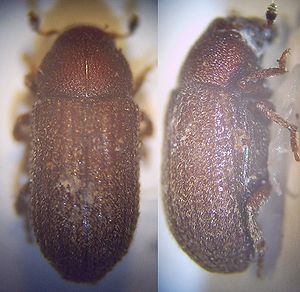Little forest gardener
| Little forest gardener | ||||||||||||
|---|---|---|---|---|---|---|---|---|---|---|---|---|

Little Forest Gardener ( Tomicus minor ) |
||||||||||||
| Systematics | ||||||||||||
|
||||||||||||
| Scientific name | ||||||||||||
| Tomicus minor | ||||||||||||
| ( Hartig , 1834) |
The little forest gardener ( Tomicus minor ) is a weevil from the subfamily of the bark beetle (Scolytinae). Since it creates its breeding systems in the bark of the host trees, it is counted among the bark breeders.
features
The beetles are 3.5 to four millimeters long and have a black-brown, cylindrical body, slightly widened at the back, shiny, not very hairy. The head is visible from above, the pronotum is similarly dotted, wider than long and narrowed in front. The front edge is straight, not indented. The forehead is slightly dotted. The basal edge of the elytra is bent up with cusps and interrupted in the middle by the label . The wing covers have rows of points. The spaces between the rows of dots have widely spaced bristles. The second gap on the fall is provided with a row of grains. The members of the elongated antennae are not separated, the antennae whip is six-membered. The eyes are not kidney-shaped. The front hips are close together. The elytra, antennae and tarsi are colored red.
distribution
The species is common in Europe . They are often found near lumber yards, especially when the lumber is lying around for a long time.
Way of life
Tomicus minor occurs on pines ( Pinus ), less often on spruce ( Picea ) and larches ( Larix ). It colonizes the bark of the trees. The flight time is from April to May. After the breeding business has ended , the old beetles penetrate the one-, two-, and less often three-year-old shoots of the jaws from the end of May for regeneration feeding, the young beetles from August for ripening feeding . The male beetles can stridulate .
Feeding picture
For oviposition, double-armed transverse passages about six to eight centimeters long are created, which have a short entrance piece at the beginning. However, these can deviate from the "normal type" if there is a high population. They run deep in the sapwood and are more likely to be found in the thin bark part of the trunk, where they can be clearly recognized from the outside by the cracking of the bark above the mother ducts when the bark is particularly thin . There are usually many boreholes to be found. The larval ducts, which are several millimeters apart, are short and only two to three centimeters long. The dolls' cradles are placed radially in the wood, so they are clearly visible even after the bark has fallen off. The shoots hollowed out during ripening and regeneration have a bored hole with a resin funnel towards the base of the shoot . They are hollowed out to the borehole. The beetles change the feeding point several times. The hollowed shoots remain green, but usually break off during the autumn winds and storms and then conspicuously cover the ground.
Generations and wintering
There is only one generation a year. The overwintering mainly takes place in the litter .
Harmful effect
The broken branches can cause great damage, especially after needle loss due to caterpillar feeding by caterpillars such as pine moth , pine moth , pine hawk and sawfly larvae such as pine bush horned sawfly. Loss of growth up to signs of death occur. Heavily infested treetops look like they have been cut, hence the name "forest gardener". The beetle seems to be more important in terms of forestry than the great forest gardener , as it tends more to a primary occurrence. He is therefore not necessarily dependent on previously damaged jaws. The mother tunnels deeply furrowing the sapwood prevent the flow of sap and, in large numbers, can lead to the death of the tree.
Systematics
Synonyms
The following synonyms are known from the literature for Tomicus minor :
- Dendroctonus minor Hartig 1834
- Myelophilus corsicus Eggers 1911
- Blastophagus minor var.corsicus Eggers 1911
swell
Individual evidence
- ↑ Tomicus minor (Hartig 1834). Fauna Europaea, Version 1.3, April 19, 2007 , accessed on September 20, 2008 .
literature
- Fritz Schwerdtfeger : Forest diseases . Paul Parey, Hamburg and Berlin 1981, ISBN 3-490-09116-7
- Sabine Grüne : Handbook for the determination of the European bark beetles . M. & H. Schaper Verlag, Hannover 1979, ISBN 3-7944-0103-4
- Edmund Reitter : Fauna Germanica - The beetles of the German Empire . Volume 5, KG Lutz, Stuttgart 1916
- Edmund Reitter: Fauna Germanica - The beetles of the German Empire . 5 volumes, Stuttgart KG Lutz 1908–1916, digital library volume 134, Directmedia Publishing GmbH, Berlin 2006, ISBN 3-89853-534-7
Web links
http://www.forestryimages.org/search/action.cfm?q=Tomicus%20minor&Start=1&results=34